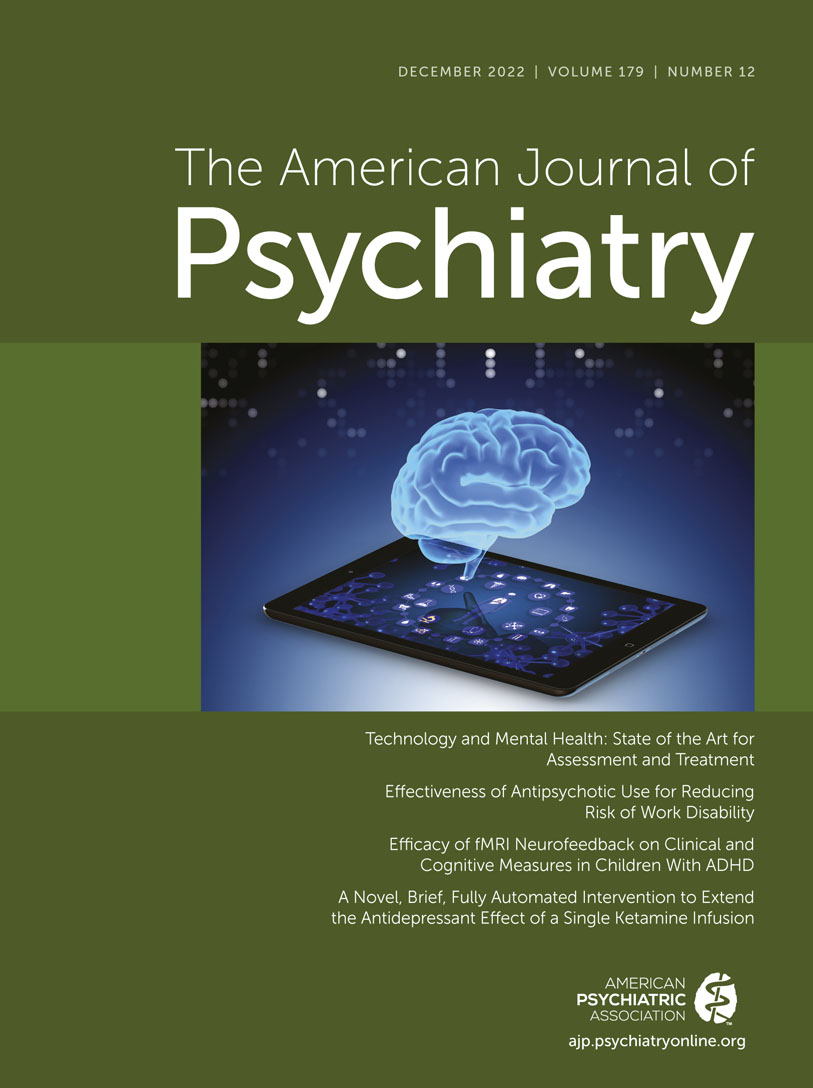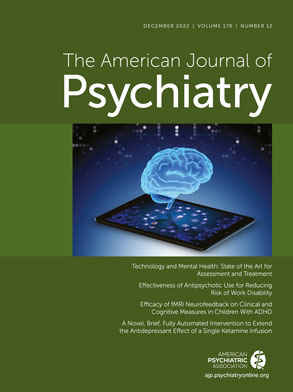The article by Price and colleagues in this issue (
1) reports that automated self-associated training (ASAT) was statistically better than sham treatment in maintaining the antidepressant response to an intravenous ketamine infusion. Ketamine given intravenously has been reported to produce rapid antidepressant and dissociative responses but to generally lose its antidepressant effect over a period of a week. Attempts to develop follow-on pharmacological treatments to extend the antidepressant effect with similar mechanisms of NMDA activity (e.g., riluzole) to prevent relapse have not been particularly successful (
2). In this study’s novel approach, a cognitive type therapy that targets implicit cognition and fosters switches from negative self-perception was studied against a sham therapy to extend the treatment response to intravenous ketamine. The approach is highly novel and offers a promising method for easily extending ketamine’s effects that is much more practical than continuing to administer ketamine intravenously, which, though effective (
3), entails considerable inconvenience, cost, and risk for tolerance and dependence.
The Price et al. study represents a step forward in extending the effect of intravenous ketamine beyond the immediate relief of depression for up to 4 weeks after the infusion, and it represents a relatively easy and cost-effective approach. The study contained a relatively large number of subjects, and the design was excellent. The authors chose to compare three treatments: ketamine infusion followed by ASAT; saline infusion followed by ASAT; and ketamine infusion followed by sham ASAT. The study was conducted under double-blind conditions, which primarily allowed for a comparison of ASAT and sham follow-up to intravenous ketamine. The ASAT treatment involved eight 15- to 20-minute sessions administered by computer over 4 days. It was conducted in a private research office. The treatment involves subliminal and supraliminal stimuli that attempt to shift thinking to a more positive personal set.
Ketamine was statistically more effective than placebo as a rapid antidepressant treatment. At 4 weeks, Montgomery-Åsberg Depression Rating Scale (MADRS) scores were significantly lower in the group that received ASAT after ketamine than in the group that received sham ASAT after ketamine. In the latter group, there was a demonstrable loss of response beginning at week 2 and continuing until at least week 4. There was a significant difference overall between the ketamine-ASAT and saline-ASAT groups in antidepressant effect. However, the difference appeared to be due largely to the difference seen in the period immediately after the infusion (i.e., to be due to the comparison of ketamine and saline).
The authors assessed the maintenance of the blind and noted that the ketamine phase expectedly appeared to violate the blind, whereas the ASAT phase did not.
There are some questions and issues that arise in this report. First, the ketamine-ASAT versus ketamine-sham comparison, while statistically significant, yielded a relatively small effect. Thus, the number needed to treat to gain one subject who does better than the control may be relatively high. This was not calculated in the study, and the limited effect may temper the enthusiasm for the approach as currently constituted. However, there may be ways to improve on the efficacy of the ASAT intervention, such as by increasing the number or duration of the sessions, better a priori selection of patients who are most likely to benefit from the sequence, and so on.
Second, the ASAT follow-up appeared to maintain the response to prior administration of both ketamine and saline. What this signifies is unclear. Does this mean that a putative active behavioral treatment can maintain the effect of a placebo response—one that is similar to its maintaining a ketamine response? The design included three cells. The lack of a placebo-placebo group leaves open some interesting questions regarding the clinical significance of ASAT. One explanation for the saline-ASAT response may be that this treatment solidifies response to any treatment (including placebo) by helping patients switch their negative mindset to more positive personal views. The authors allude to the potential independent effect of ASAT, and this appears worthy of further study. The treatment may be beneficial to a patient with depression who is beset by negative self-percepts, implicit or explicit. However, the positive benefits of ASAT after both ketamine and placebo suggest that the authors’ hypothesis that ASAT’s mechanism of action involves specifically adding to the long-term potentiation properties of ketamine is likely incorrect, since the same effect is seen in the patient group treated with sham ASAT. Assuming that ASAT has independent antidepressant effects, one may wonder why it did not have additive effects to ketamine’s in terms of further and greater decreases in rating scale scores after the infusion rather than only preventing loss of response. Here, one can speculate on a number of explanations: 1) Ketamine’s antidepressant effect seen here may represent the maximal obtainable effect with single-dose (and perhaps even with multiple-dose) therapy. 2) ASAT may not act quickly enough to rapidly provide any added benefit over a single dose when it is started after the ketamine. It may be worth exploring initiation of ASAT before infusion to see if this could enhance the acute ketamine effect. 3) It may turn out that ASAT is, in the end, best used to prevent relapse after ketamine treatment rather than to enhance its effect. We need to understand better what the behavioral treatment is actually doing and how it may interact with the response to ketamine or placebo.
Third, the effect of the behavioral treatment is intriguing and does raise questions as to ketamine’s effects. We tend to think about ketamine being a primary antidepressant, but there are indications that its cognitive effects may be more important than its mood-elevating effects. In a combined analysis of ketamine versus control studies in major depression, it appeared that the antisuicidal effects of ketamine are greater and more sustained than the antidepressant effects (
4). Suicidal behavior includes major preoccupation with negative and self-destructive percepts. Furthermore, Rodriguez et al. (
5) have reported on pronounced and sustained (beyond 1 week) effects of ketamine in nondepressed obsessive-compulsive patients. These data point to a major and perhaps primary cognitive effect of ketamine, and this effect may be reinforced by ASAT follow-up treatment. We are currently exploring aspects of the cognitive effects of ketamine in a study involving intravenous ketamine in suicidal patients with unipolar depression.
Fourth, while the data in this study point to ketamine being more effective than saline as an antidepressant as measured by the MADRS, the patients in the study did show considerable response to the intravenous saline control. This may be viewed as patients anticipating their possibly receiving ketamine as well as the positive, nonspecific effects of placebo treatment. The authors were laudably diligent in assessing the maintenance of the blind, notably because the avoidance of interrogating the blind is so common today in studies examining the effects of mind-altering agents (
6,
7). However, it is obvious that in many studies the blind is violated in relation to ketamine and other drugs—understandably so, given their effects—and we must be careful when we assess studies in this area.
The authors are to be commended for developing the application of an intriguing treatment for extending the effects of ketamine. This study is innovative, well powered, and elegant in design and implementation and appears to be a potentially major step forward in follow-up treatment after acute intravenous infusions of ketamine.

